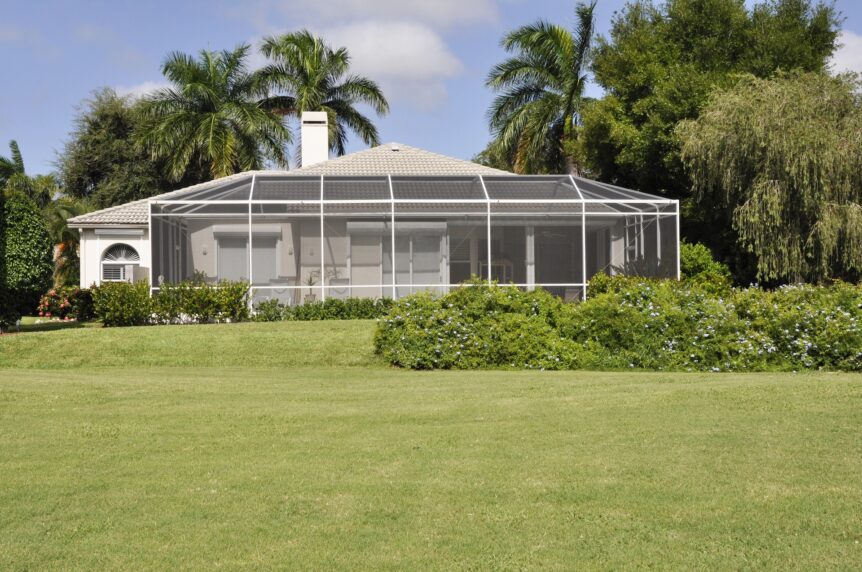Seasonal Lawn Care Tips for Southwest Florida
Maintaining a lush, healthy lawn in Southwest Florida requires a tailored approach due to the region’s unique climate. With the area’s distinct seasons, knowing how to care for your lawn year-round is key to ensuring it thrives. Here’s a guide to seasonal lawn care for homeowners in Venice, Sarasota, and Bradenton.
Winter (December – February): Preparing for Cooler Months
Lawn Care:
- Mowing: Grass growth slows down during the winter, so reduce the mowing frequency. Keep your grass a bit longer, around 3-4 inches, to protect it from potential cold snaps.
- Watering: Winter typically brings more consistent rainfall, so monitor your lawn’s moisture levels to avoid overwatering. Water only if rainfall is insufficient, as too much water can lead to disease.
Pest Control:
- Monitor for Pests: While some pests become less active, others like chinch bugs can still be a threat. Regular inspections can help catch infestations early.
- Preventive Treatment: Apply a preventive pest control treatment to keep overwintering pests at bay.
Fertilization:
- Limit Fertilizer: Fertilizing heavily in winter isn’t necessary and can lead to excessive growth that stresses your lawn. Instead, apply a slow-release fertilizer in early winter to sustain your lawn through the cooler months.
Spring (March – May): Reviving Your Lawn
Lawn Care:
- Aeration: Spring is an ideal time to aerate your lawn. This process helps relieve soil compaction and allows air, water, and nutrients to penetrate the roots more effectively.
- Dethatching: Remove thatch buildup to improve air circulation and water absorption. This also reduces the likelihood of pests and diseases.
- Mowing: Resume regular mowing, but don’t cut more than one-third of the grass blade at a time to avoid stressing the lawn.
Pest Control:
- Early Detection: As temperatures rise, pests like grubs and sod webworms become more active. Early spring is the best time for preventive treatments to stop infestations before they start.
Fertilization:
- Balanced Fertilizer: Use a balanced, slow-release fertilizer to kickstart your lawn’s growth. Look for a formula with a balanced mix of nitrogen, phosphorus, and potassium to support strong root development and vibrant green growth.
Summer (June – August): Managing Heat and Humidity
Lawn Care:
- Mowing: Mow regularly, keeping the grass at 2.5-3 inches. This height provides shade for the soil, reducing water evaporation and cooling the root zone.
- Watering: With summer’s intense heat, your lawn needs about 1-1.5 inches of water per week. Water deeply and infrequently to encourage deep root growth, and avoid watering in the evening to prevent fungal diseases.
Pest Control:
- Vigilant Monitoring: Pests like chinch bugs, armyworms, and mole crickets thrive in the summer. Regular inspections and prompt treatment are essential to keeping your lawn pest-free.
- Targeted Treatments: Use targeted insecticides if pests are detected, but always follow the manufacturer’s instructions to minimize environmental impact.
Fertilization:
- High-Nitrogen Fertilizer: Summer is the time for high-nitrogen fertilizers to fuel growth during peak growing season. However, be cautious not to over-fertilize, as this can lead to thatch buildup and make your lawn more susceptible to disease.
Fall (September – November): Preparing for Dormancy
Lawn Care:
- Mowing: Gradually lower your mowing height as temperatures cool to avoid excessive growth going into winter. However, don’t cut it too short to protect the grass from the first frost.
- Overseeding: If you have bare or thin patches, fall is an excellent time to overseed. The cooler weather and more consistent rainfall provide ideal conditions for new grass to establish.
Pest Control:
- Last-Minute Checks: Pests like fall armyworms can cause significant damage before winter. Apply pest control measures if necessary, focusing on areas that showed signs of stress during the summer.
- Pre-Winter Treatment: Consider a pre-winter pest treatment to protect your lawn from pests that could overwinter and become a problem in spring.
Fertilization:
- Winterizer Fertilizer: Apply a winterizer fertilizer high in potassium. This helps strengthen your lawn’s roots, making it more resilient to cold weather and ready for a healthy start in spring.
Seasonal Lawn Care Tips – FAQ
Q: How often should I aerate my lawn in Southwest Florida?
A: Aerate your lawn at least once a year, preferably in spring, to relieve compaction and enhance nutrient absorption.
Q: Is it necessary to fertilize my lawn in winter?
A: Fertilizing heavily in winter isn’t recommended. Instead, use a slow-release fertilizer in early winter to maintain steady growth without overstimulating the grass.
Q: How can I prevent pests from damaging my lawn year-round?
A: Regular monitoring, combined with seasonal preventive treatments, can keep most pests at bay. Adjust your approach based on the time of year and the specific pests common to Southwest Florida.
For more personalized advice or help with your lawn care needs, contact Lawn Care Extraordinaire today! We’re here to help you keep your lawn healthy and beautiful year-round.
Ready to elevate your outdoor space with Lawn Care Extraordinaire? Schedule a consultation and stay connected through social media and newsletters for the latest tips and updates. Take the first step towards a healthier, more beautiful, and pest-free lawn today.

